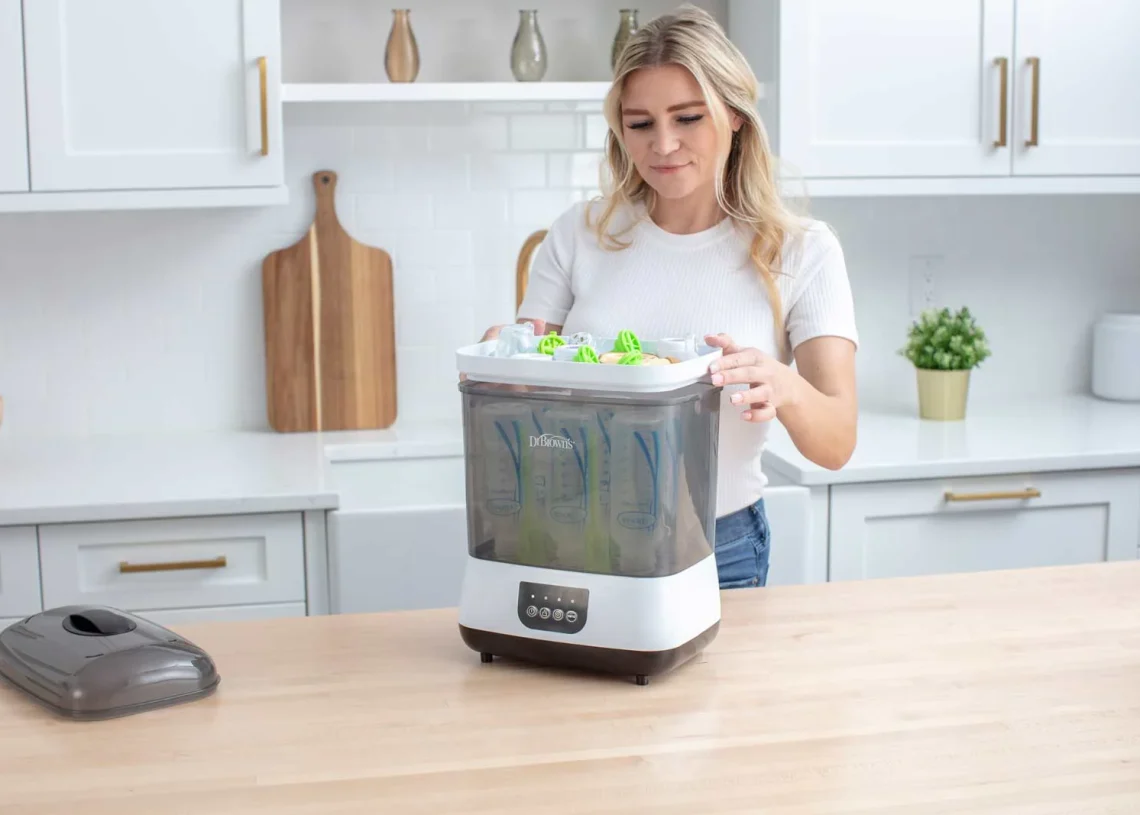The Baby Brezza Sterilizer is an essential device for parents who want to keep their baby’s bottles, pacifiers, and other accessories germ-free.
However, like any other appliance that deals with water and heat, it requires regular cleaning to maintain efficiency and hygiene.
Over time, mineral deposits, mold, and bacteria can accumulate, potentially affecting the performance of the sterilizer.
This guide will walk you through the entire cleaning process, from daily maintenance to deep cleaning, ensuring that your Baby Brezza Sterilizer remains in optimal condition.
Why Cleaning the Baby Brezza Sterilizer Is Important
Before diving into the cleaning process, let’s first understand why regular maintenance is crucial:
- Prevents mineral buildup: Hard water leaves behind calcium and limescale deposits that can reduce efficiency.
- Eliminates bacteria and mold: Moist environments can harbor bacteria and mold, making proper cleaning essential.
- Ensures optimal performance: A clean sterilizer works better and lasts longer.
- Keeps bottles truly sterile: If the sterilizer itself is dirty, it cannot effectively sterilize baby bottles.
How Often Should You Clean It?
- Daily: Wipe down the sterilizer after each use to prevent residue buildup.
- Weekly: Descale and deep clean the heating plate to remove mineral deposits.
- Monthly: Perform a thorough cleaning, including all removable parts.
What You’ll Need for Cleaning
- White distilled vinegar (for descaling)
- Mild dish soap
- Soft sponge or cloth
- Non-abrasive brush (or an old toothbrush)
- Measuring cup
- Clean water
- Paper towels or a clean dish towel
Step-by-Step Cleaning Guide
Step 1: Unplug and Disassemble
Before cleaning, unplug the sterilizer and allow it to cool down completely. Then, remove all detachable parts, including:
- Bottle racks
- Lid
- Water reservoir
- Any additional accessories
Place these parts aside for separate cleaning.
Step 2: Cleaning the Removable Parts
Wash with Soap and Water
- Fill your sink with warm soapy water.
- Submerge all removable parts and scrub gently with a sponge or brush.
- Rinse thoroughly to remove any soap residue.
Air Dry or Wipe Dry
- Let the parts air dry on a clean dish rack or wipe them down with a dry towel.
Step 3: Descaling the Heating Plate
One of the most crucial parts of cleaning is descaling the heating plate, as mineral deposits can build up over time and reduce efficiency.
How to Descale Using Vinegar
Prepare the Solution
- Mix 1 part white vinegar with 2 parts water in a measuring cup.
- Pour the solution directly onto the heating plate at the base of the sterilizer.
Let It Sit
- Allow the solution to sit for 30-60 minutes to break down mineral buildup.
Scrub Gently
- Use a soft cloth or non-abrasive brush to scrub away any remaining residue.
Rinse Thoroughly
- Wipe down the heating plate with a clean damp cloth to remove all vinegar traces.
Step 4: Cleaning the Interior and Exterior
Wipe Down the Inside
- Use a damp cloth to clean the interior walls of the sterilizer.
- Ensure no water or soap residue is left behind.
Clean the Exterior
- Wipe the outer surface with a mildly damp cloth to remove dust and smudges.
Step 5: Reassemble and Dry
- Once all parts are completely dry, reassemble the sterilizer.
- Plug it back in, and it’s ready for use!
Additional Maintenance Tips
- Use distilled water: This helps prevent limescale buildup inside the sterilizer.
- Clean after every few uses: If you notice white or chalky deposits, clean the unit sooner rather than later.
- Avoid harsh chemicals: Never use bleach or strong chemicals, as they can leave harmful residues.
- Store properly: Keep the sterilizer in a dry, ventilated area when not in use.
Common Questions & Troubleshooting
1. Why does my Baby Brezza Sterilizer smell bad?
A foul odor usually comes from stagnant water or bacteria buildup. Regular cleaning and drying the unit completely after each use can prevent this issue.
2. How do I remove stubborn limescale?
For tougher deposits, try leaving vinegar on the heating plate overnight before scrubbing.
3. Can I put sterilizer parts in the dishwasher?
Some removable parts may be top-rack dishwasher safe, but always check the user manual to be sure.
4. My sterilizer isn’t working properly after cleaning. What should I do?
Make sure all parts are completely dry and reassembled correctly. Also, check if any mineral buildup remains on the heating plate.
Conclusion
Keeping your Baby Brezza Sterilizer clean ensures your baby’s bottles remain truly sterilized and safe to use.
By following this simple cleaning routine, you can prevent buildup, extend the life of your sterilizer, and keep your baby’s feeding essentials hygienic.
Regular maintenance only takes a few minutes but makes a world of difference in the performance of your sterilizer.
Start incorporating these cleaning habits today for a safer and healthier feeding experience!




























